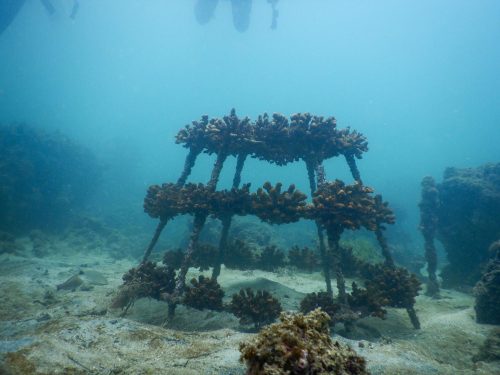
Coral reefs are very important to coastal communities. Since they are the habitat of up to 4,000 different fish species, they can support traditional and commercial fishing, as well as tourism with activities such as snorkeling.
Their wide diversity of colors, which make them so attractive, is provided by microalgae called zooxanthellae. The interaction between corals and microalgae is vital for the colony’s survival, as corals depend on the food generated by zooxanthellae during photosynthesis, which helps them develop and grow. On the other hand, corals return the favor by providing compounds that microalgae need to photosynthesize.
Healthy corals act as barriers that protect shorelines from waves, storms and flooding. But they are increasingly threatened by disease, pollution and habitat destruction. This year, once again, the threats also include the 0.5 to 2 degree increase in the average ocean temperature due to El Niño.
With this increase, the symbiotic relationship between coral and microalgae is broken. As a result, the corals lose their vibrant colors and appear white. Beyond that, this means that they have a hard time growing or reproducing. Eventually the worst happens: they die.
In Costa Rica, these effects have started to be observed in reefs in different areas of the Pacific, such as the ones in Sámara, Caño Island, Cocos Island and Salinas Bay.
High-intensity El Niño events have caused high coral mortalities in Costa Rica’s Pacific and Caribbean areas in the years 1982-1983, 1997-1998 and 2015-2016. During El Niño, the trade winds, normally responsible for moving warm water to the east, Australia and Asia, weaken, causing an accumulation of warm water in the western Pacific basin.
El Niño currently has moderate to severe characteristics, but the United States National Oceanic and Atmospheric Administration (NOAA) forecasts that its effects will increase by October of 2023.

Bleached Pocillopora spp. coral colony in Zapotillal
In addition, the temperature has gone up 0.6°C in the last 30 years, causing an increasing warming of the oceans. This year,the highest temperatures ever recorded were reached in July. It’s an unprecedented situation, which will probably be repeated more intensely as the El Niño phenomenon develops and its impacts will still be felt in 2024.
There are times when coral can recover from bleaching. If conditions normalize for an extended time, zooxanthellae (algae) can return to corals and restore their colors and life, although this can take decades.
That’s why it’s important to reduce our carbon footprint to help prevent annual temperature increases from exceeding 1.5°C. There are many ways in which each one of us can contribute to these goals. What are some of the actions we can take?
- Conserve and reduce the water we use
- Eat sustainably caught fish and shellfish
- Check to make sure the ingredients of sunscreens don’t have compounds that are harmful to the reefs.
Although it’s crucial to recognize the impact that we have on the reefs as individuals, it is clear that the greatest responsibility lies with large industries, the main emitters of carbon dioxide due to burning fossil fuels.
The conservation of these ecosystems and the mitigation of coral bleaching, aggravated by El Niño, require collaboration and concrete efforts. Climate change needs to be managed to effectively mitigate coral bleaching, which requires global efforts.
____________________________________________________________________________________
Andrea Bogantes is a biology student at the University of Costa Rica (UCR).
This article is the author’s opinion and does not necessarily reflect the editorial position of this medium. If you want to share an opinion article, send an email to [email protected]







Comments